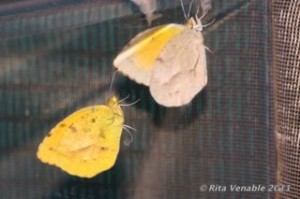In order to illustrate butterflies for Butterflies of Tennessee, I rear butterfly eggs or caterpillars, to chrysalises, to adults so I can photograph their life cycles. (This is a time-consuming and tedious process that I recommend only if there is a specific reason for doing it!) After I have photographed the butterflies, I release them back into the area where they were found which is usually in my back yard.
The Sleepy Orange adults (below) were found as eggs or caterpillars in late September or early October on southern wild senna (Senna marilandica) that I grow in my yard. I do not know if they were siblings or not. They were raised outside and subject to temperatures and daylight hours that nature provided.
When they emerged from their chrysalises, which was within 24 hours of each other on Oct. 26, they looked very different. One was the fall or winter form with brownish hindwings, while the other was the summer form with more yellow hindwings.
When I would see Sleepy Oranges outside in the fall, I thought that the fall/winter forms were migratory or came from somewhere else, and the summer forms, which could be in the same area, were from another area. Now I see that the two can come from the same yard at relatively the same time and still look very different.
I wish I could draw a conclusion from this, but the photos only bring questions: Is the color difference because of male/female differences, daylight hours at a particular stage, temperatures at a particular stage or genetic make-up?
©Rita Venable 2011
